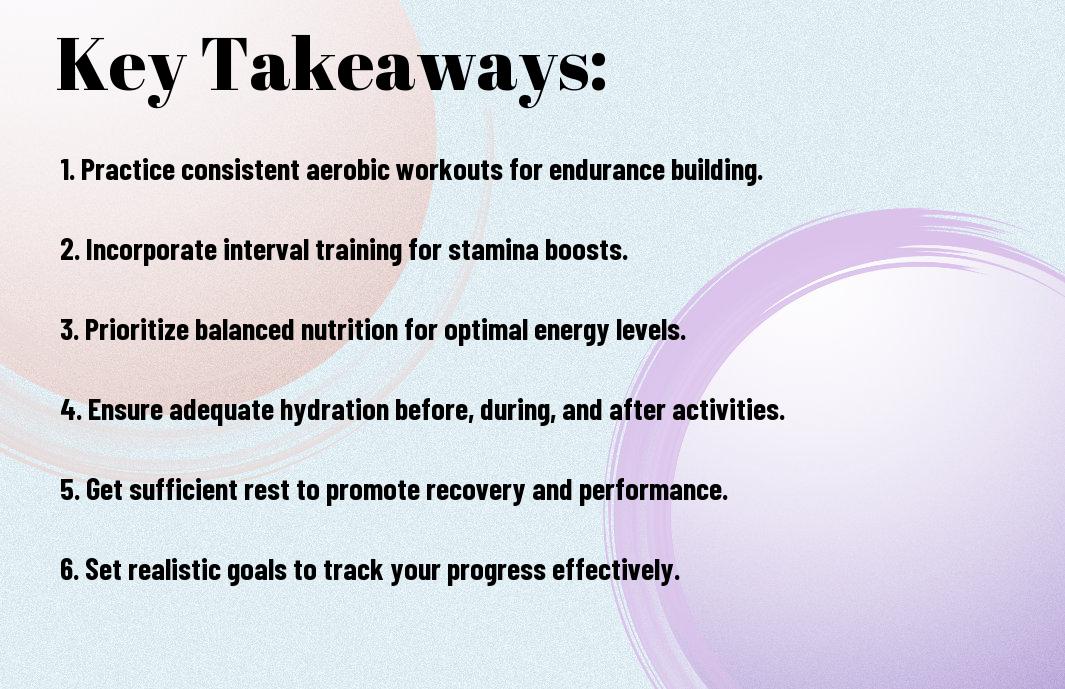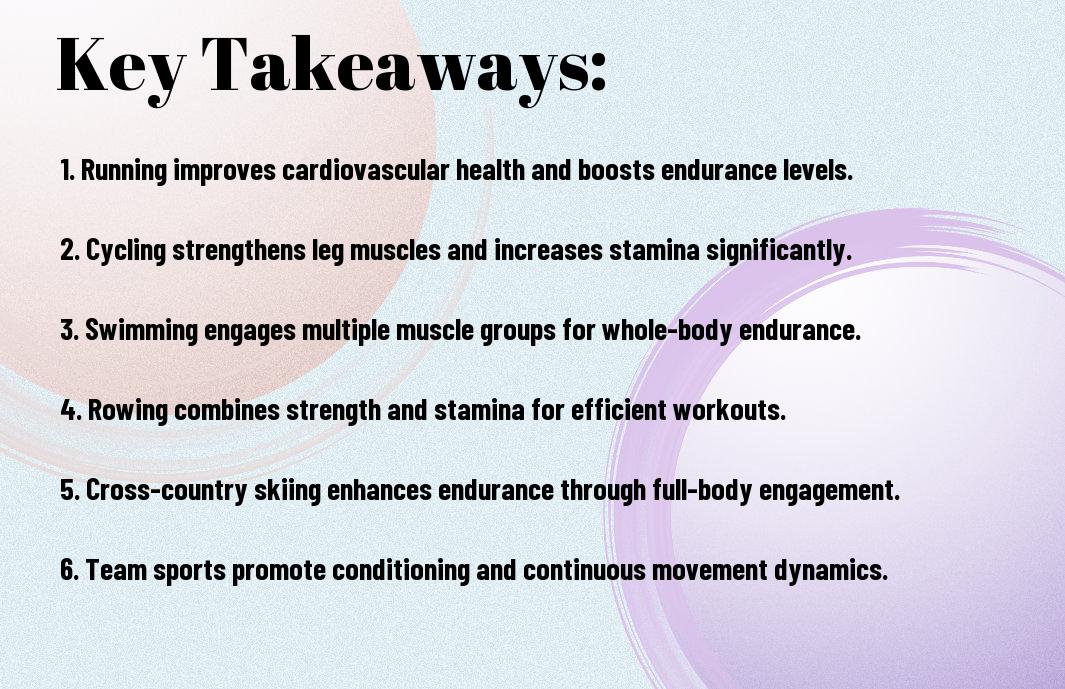Most athletes understand that stamina is key to performance, yet many struggle to enhance it effectively. If you’re looking to elevate your endurance during sports, implementing specific strategies can make a significant difference. In this post, you’ll discover five practical methods that will help you boost your stamina, allowing you to push through those challenging moments in games and training. From optimizing your workouts to focusing on nutrition, these tips will provide you with a solid foundation to improve your athletic performance and achieve your goals.
Key Takeaways:
- Consistent Training: Engaging in regular workouts helps build endurance and enhances overall stamina.
- Balanced Nutrition: Consuming a diet rich in carbohydrates, proteins, and healthy fats fuels the body and supports stamina during sports activities.
- Hydration: Staying properly hydrated is important for maintaining energy levels and preventing fatigue during intense workouts.
- Interval Training: Incorporating high-intensity interval training (HIIT) increases both aerobic and anaerobic capacity, improving stamina significantly.
- Rest and Recovery: Allowing the body adequate time to rest and recuperate is vital for sustaining energy levels and enhancing performance in the long run.
Understanding Stamina
The term stamina refers to your body’s ability to sustain prolonged physical or mental effort. It indicates your endurance levels, determining how long you can perform an activity before fatigue sets in. Developing stamina is necessary for athletes as it impacts overall performance during training and competition.
Definition of Stamina
Below is a simple definition: stamina is the physical or mental capacity to endure strenuous activity over time. It encompasses both aerobic capacity and muscle endurance, allowing you to push through challenges in your chosen sport.
Importance of Stamina in Sports
Along with strength and skill, stamina significantly contributes to your success in sports. A higher endurance level enables you to train longer, compete effectively, and recover more quickly, enhancing your overall athletic performance.
The significance of stamina cannot be overstated in sports. When you possess strong stamina, you can maintain your performance throughout an entire event, keeping your energy levels steady. This endurance allows you to execute skills effectively, react to opponents, and finish strong, giving you a competitive edge. Moreover, improved stamina enhances your mental toughness, enabling you to push through fatigue and challenges, which is vital for achieving your sports goals.

Incorporating Aerobic Exercise
There’s no better way to boost your stamina for sports than by integrating aerobic exercise into your fitness routine. Aerobic workouts improve your endurance, enhance your cardiovascular health, and help you perform better in high-intensity sports. By engaging in consistent aerobic activities, you enable your body to effectively use oxygen, which in turn, increases your stamina levels and overall athletic performance.
Types of Aerobic Workouts
There’s a variety of aerobic workouts you can choose from to improve your stamina. Consider incorporating the following into your routine:
- Running or jogging
- Cycling
- Swimming
- Dancing or Zumba
- Rowing
Assume that varying your workouts will not only keep things interesting but also target different muscle groups, providing comprehensive benefits.
| Type of Workout | Duration (minutes) |
|---|---|
| Running | 30-60 |
| Cycling | 30-90 |
| Swimming | 30-60 |
| Dancing | 30-60 |
| Rowing | 20-45 |
Frequency and Duration Guidelines
At a minimum, you should aim for at least 150 minutes of moderate aerobic exercise per week, or 75 minutes of vigorous aerobic activity, spread across multiple days. This ensures that you build your stamina gradually while allowing your body sufficient recovery time between sessions.
Even a steady progression in your aerobic routine can lead to significant improvements in your stamina. Aim for about 30 minutes of aerobic exercise, five times a week. You can start with shorter sessions and gradually increase the duration as your fitness level improves. Combining different types of workouts will not only challenge you but also keep your training enjoyable and engaging. Make it a point to listen to your body and adjust your routine accordingly to ensure long-term success.

Strength Training for Endurance
Despite the common misconception that strength training is solely for building muscle, it plays a vital role in enhancing your endurance for sports. By incorporating strength exercises into your routine, you can improve your muscle efficiency, allowing you to perform at a higher level for extended periods. This not only increases your stamina but also helps prevent injuries, giving you a more balanced and robust foundation to excel in your chosen sport.
Key Exercises for Athletes
With a focus on endurance, athletes should incorporate functional strength exercises such as squats, lunges, and deadlifts into their training. These movements engage multiple muscle groups and mimic the motions involved in various sports, enhancing your overall performance. Additionally, exercises like push-ups and planks are excellent for building upper body and core strength, allowing you to maintain your energy levels throughout the competition.
Benefits of Strength Training
An effective strength training routine can lead to improved athletic performance, as it boosts your muscle endurance and overall physical capacity. By increasing your strength, you become more efficient at utilizing energy during prolonged activities, allowing you to push through fatigue longer and with greater ease.
To truly grasp the benefits of strength training, consider that it not only enhances your endurance but also contributes to better coordination, balance, and agility. It builds lean muscle mass, which helps to improve your metabolism and recovery times. As you strengthen your muscles, tendons, and ligaments, you’ll also experience a notable reduction in injury risk, enabling you to train harder and longer while enjoying the activities you love. By integrating strength training into your routine, you empower yourself to reach new performance heights in your sports endeavors.
Nutrition for Optimal Performance
To enhance your stamina for sports, proper nutrition is vital. Fueling your body with the right nutrients can significantly improve your performance and endurance levels. By focusing on a balanced diet rich in carbohydrates, proteins, and healthy fats, you ensure that your body has the energy it needs during intense training and competitions. Additionally, hydration plays an important role in maintaining optimal performance, so it’s vital to pay attention to what you consume before, during, and after your activities.
Nutritional Components for Stamina
After understanding the importance of nutrition, it’s vital to focus on specific components that boost stamina. Carbohydrates are your primary source of energy, while proteins help repair and build muscle tissue. Healthy fats provide vital fatty acids and energy for longer workouts. Incorporating fruits and vegetables ensures you receive necessary vitamins and minerals that play a role in overall health and recovery, helping you maintain peak performance.
Meal Timing and Hydration
Below, you’ll find tips on how meal timing and hydration can significantly impact your stamina. Eating the right foods at the appropriate times allows your body to optimize energy levels and recovery. Staying well-hydrated before, during, and after your workouts is equally important as it supports digestion, muscle function, and overall performance.
With meal timing, you should focus on consuming carbohydrates and proteins within 30 minutes to two hours after your workout to maximize muscle recovery. Prior to your activities, having a balanced meal or snack can fuel your performance effectively. In terms of hydration, aim to drink water consistently throughout the day but pay special attention to fluid intake before, during, and after exercise to prevent dehydration. Utilizing electrolyte-rich beverages during longer sessions can also help maintain energy and endurance.
Rest and Recovery
Unlike what many athletes believe, rest and recovery are just as vital as training when it comes to improving your stamina. Overworking your body can lead to fatigue and burnout, making it harder for you to perform at your best. Implementing adequate rest periods can enhance your overall performance and help you achieve your stamina goals. Prioritizing recovery days in your training schedule will allow your muscles to repair and grow stronger, ultimately benefiting your endurance in sports.
Importance of Sleep
With an increased focus on your training, sleep often takes a backseat, but it’s imperative for stamina improvement. Quality sleep helps to recharge your muscles, restore energy levels, and supports cognitive functions necessary for peak performance. Aim for 7-9 hours of uninterrupted sleep each night to facilitate the body’s recovery processes and enhance your athletic capabilities. Good sleep hygiene practices, such as maintaining a consistent schedule and optimizing your sleep environment, will significantly impact your performance outcomes.
Active Recovery Techniques
About incorporating active recovery techniques can vastly improve your stamina. These methods involve gentle physical activities that promote blood circulation, reduce muscle soreness, and assist in the recovery process without adding significant strain to your body. Activities like walking, cycling, or yoga can help maintain your fitness levels while allowing your muscles to heal.
Further exploring active recovery techniques, you might consider engaging in low-intensity activities that keep you moving while aiding muscle recovery. For instance, a leisurely swim or a light jog can be highly effective. Stretching and foam rolling are also beneficial for enhancing flexibility and relieving tension in your muscles. This balance of activity and relaxation allows your body to recover more efficiently, resulting in improved stamina for your next training session or competition.
Mental Strategies for Endurance
Now, building your stamina is not only about physical training; it also requires strong mental strategies. Developing a resilient mindset can enhance your endurance and help you push through challenging moments during sports activities. Incorporating mental exercises into your training routine will allow you to stay focused and maintain motivation, ultimately improving your performance.
Mindfulness and Focus Techniques
After incorporating mindfulness techniques into your routine, you can sharpen your focus and enhance your endurance during sports. Practicing mindfulness involves being fully present in your activities, which helps you manage stress and improve your overall performance. Techniques such as deep breathing, visualization, and meditation can keep distractions at bay, allowing you to concentrate on your goals.
Setting Realistic Goals
Around setting goals, it’s crucial to create realistic and achievable targets that align with your current abilities and desired outcomes. This practice helps maintain motivation and allows for steady progress, which ultimately fosters a sense of accomplishment. By breaking larger goals into smaller, manageable milestones, you can track your progress effectively and adjust your training regimen as needed.
Indeed, setting realistic goals is fundamental to enhancing your stamina in sports. Focusing on small, incremental improvements rather than overwhelming yourself with lofty expectations ensures that you stay motivated and avoid burnout. Celebrate your achievements along the way, no matter how small, as they contribute to your overall growth. Over time, this approach builds confidence while keeping your motivation high, allowing you to enhance your stamina sustainably.
To Wrap Up
From above, you now have a clear understanding of how to enhance your stamina for sports. By incorporating a balanced diet, consistent training, adequate rest, hydration, and mental conditioning, you can elevate your performance. These strategies work together to help you build endurance and achieve your athletic goals. For more insights on improving your stamina, check out this resource on How to Increase Stamina: 16 Ways to Power Up a Workout.
Q: What are some effective exercises to boost my stamina for sports?
A: To improve your stamina for sports, consider incorporating a variety of aerobic and anaerobic exercises into your routine. Long-distance running or cycling can enhance your cardiovascular endurance, while interval training—alternating short bursts of high-intensity activity with periods of rest—can build both stamina and power. Activities like circuit training that combine strength and aerobic workouts can also be beneficial. Lastly, consider sports-specific drills that mimic the movements and intensity of your chosen sport to condition your body accordingly.
Q: How does nutrition play a role in enhancing my stamina for sports?
A: Nutrition is vital for building and maintaining stamina. A balanced diet rich in carbohydrates, proteins, and healthy fats provides the energy required for prolonged physical activity. Carbohydrates serve as the primary fuel source, so including whole grains, fruits, and vegetables is important. Protein supports muscle repair and recovery, making lean meats, fish, legumes, and dairy products important. Staying hydrated is also key; water and electrolyte-rich drinks help maintain performance during extended periods of exercise. Consulting with a sports nutritionist can help tailor your diet to meet your specific stamina-related needs.
Q: How important is rest and recovery in improving my sports stamina?
A: Rest and recovery are vital elements in any training program aimed at boosting stamina. When you engage in intense workouts, your muscles experience micro-tears that need time to heal. Incorporating rest days into your training schedule allows your body to repair itself, building stronger muscles and enhancing endurance over time. Active recovery, such as gentle stretching, yoga, or light cardio, can also promote recovery without completely halting your training. Adequate sleep is equally important, as it helps to regulate hormones and supports overall recovery and performance. Balancing training with sufficient rest will lead to greater advancements in stamina.


